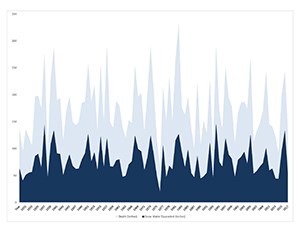
Although both seasonal and fleeting, snowpack is a valuable natural resource. The snow at Lassen Volcanic provides superb winter recreation and creates a winter habitat to which park animals and plants are well-adapted. Lassen Peak Snowpack MeasurementsPark staff began collecting measurements at the Lower Lassen Peak (LLP) snow course in 1930. Today, more than 50 state, national, and private agencies pool their efforts in collecting snow data throughout California. Visitors to the Lake Helen picnic area (8,250 feet elevation) may have spotted the 36-foot-tall snow sensor that collects and transmits real-time data to specialists at the California Department of Water Resources. Data from the Lower Lassen Peak remote station is manually verified four times each winter by a surveyor. View LLP sensor measurements (hourly/daily) or manual measurements (January - April) including manual measurement history since 1930. 2025 Lower Lassen Peak Manual Measurements
|
Last updated: March 28, 2025



